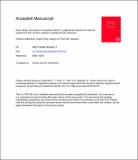Does rising crime lead to increasing distress? Longitudinal analysis of a natural experiment with dynamic objective neighbourhood measures
Abstract
Identifying ‘neighbourhood effects’ to support widespread beliefs that where we live matters for our health remains a major challenge due to the reliance upon observational data. In this study we reassess the issue of local crime rates and psychological distress by applying unobserved bias models to a sample of participants who remain in the same neighbourhoods throughout the study. Baseline data was extracted from the 45 and Up Study between 2006 and 2008 and followed up as part of the Social Economic and Environmental Factors (SEEF) Study between 2009 and 2010. Kessler 10 scores were recorded for 25 545 men and 29 299 women reported valid outcomes. Annual crime rates per 1,000 (including non-domestic violence, malicious damage, break and enter, and stealing, theft and robbery) from 2006 to 2010 inclusive were linked to the person-level data. Change in exposure to crime among participants in this study, therefore, occurs as a result of a change in the local crime rate, rather than a process of neighbourhood selection. Gender stratified unobserved bias logistic regression adjusting for sources of time-varying confounding (age, income, employment, couple status and physical functioning) indicated that an increase in the risk of experiencing psychological distress was generally associated with an increase in the level of neighbourhood crime. Effect sizes were particularly high for women, especially for an increase in malicious damage (Odds Ratio Tertile 3 vs Tertile 1 2.40, 95% Confidence Interval 1.88, 3.05), which may indicate that damage to local built environment is an important pathway linking neighbourhood crime with psychological distress. No statistically significant association was detected for an increase in non-domestic violence, although the effect was in the hypothesised direction. In summary, the application of unobserved bias models to analyse data that takes into account the temporally dynamic characteristics of where people live warrants further investigation.
Citation
Astell-Burt , T E , Feng , X , Kolt , G S & Jalaludinf , B 2015 , ' Does rising crime lead to increasing distress? Longitudinal analysis of a natural experiment with dynamic objective neighbourhood measures ' , Social Science and Medicine . https://doi.org/10.1016/j.socscimed.2015.05.014
Publication
Social Science and Medicine
Status
Peer reviewed
ISSN
0277-9536Type
Journal article
Collections
Items in the St Andrews Research Repository are protected by copyright, with all rights reserved, unless otherwise indicated.

